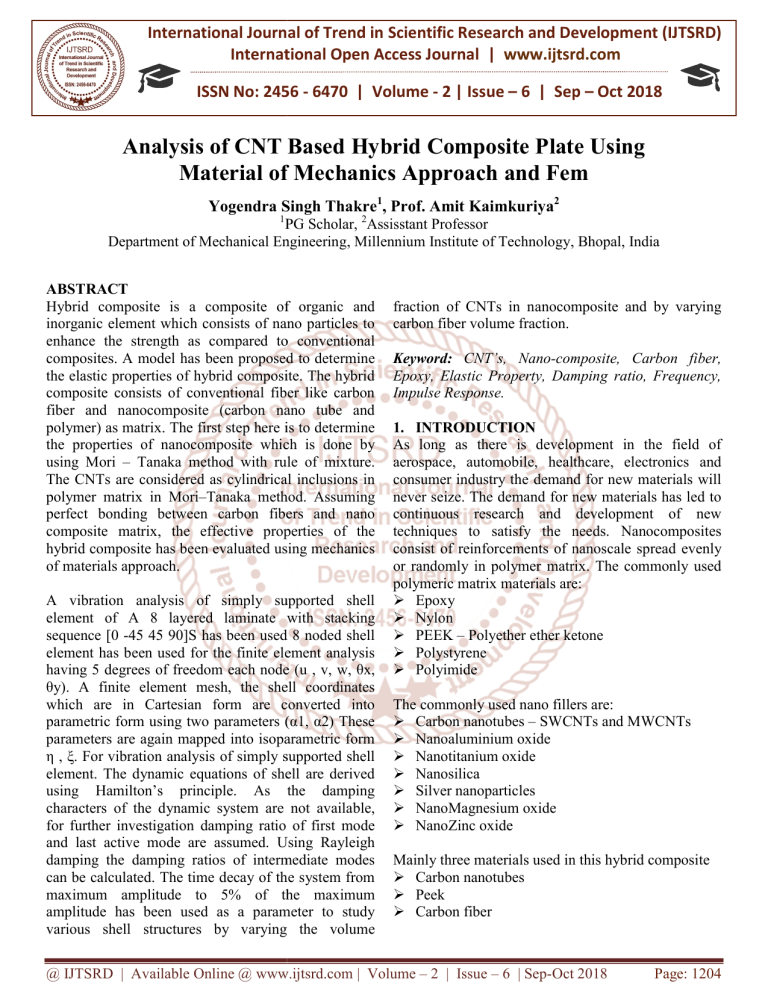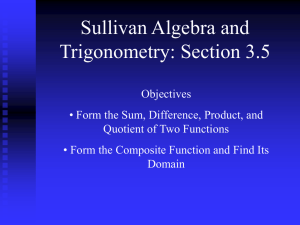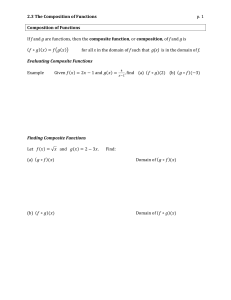
International Journal of Trend in Scientific Research and Development (IJTSRD)
International Open Access Journal | www.ijtsrd.com
ISSN No: 2456 - 6470 | Volume - 2 | Issue – 6 | Sep – Oct 2018
Analysis of CNT Based Hybrid Composite Plate Using
U
Material of Mechanics Approach and Fem
Yogendra Singh Thakre1, Prof. Amit Kaimkuriya2
1
PG Scholar, 2Assisstant Professor
Department of Mechanical Engineering
Engineering, Millennium Institute of Technology,, Bhopal, India
ABSTRACT
Hybrid composite is a composite of organic and
inorganic element which consists of nano particles to
enhance the strength as compared to conventional
composites. A model has been proposed to determine
the elastic properties of hybrid composite. The hybrid
composite consists of conventional fiber like carbon
fiber and nanocomposite (carbon nano tube and
polymer) as matrix. The first step here is to determine
the properties of nanocomposite
anocomposite which is done by
using Mori – Tanaka method with rule of mixture.
The CNTs are considered as cylindrical inclusions in
polymer matrix in Mori–Tanaka
Tanaka method. Assuming
perfect bonding between carbon fibers and nano
composite matrix, the effectivee properties of the
hybrid composite has been evaluated using mechanics
of materials approach.
A vibration analysis of simply supported shell
element of A 8 layered laminate with stacking
sequence [0 -45
45 45 90]S has been used 8 noded shell
element has been used for the finite element analysis
having 5 degrees of freedom each node (u , v, w, θx,
θy). A finite element mesh, the shell coordinates
which are in Cartesian form are converted into
parametric form using two parameters (α1, α2) These
parameters are again mapped into isoparametric form
η , ξ. For vibration analysis of simply supported shell
element.
ment. The dynamic equations of shell are derived
using Hamilton’s principle. As the damping
characters of the dynamic system are not available,
for further investigation damping ratio of first mode
and last active mode are assumed. Using Rayleigh
damping the
he damping ratios of intermediate modes
can be calculated. The time decay of the system from
maximum amplitude to 5% of the maximum
amplitude has been used as a parameter to study
various shell structures by varying the volume
fraction of CNTs in nanocomposite
mposite and by varying
carbon fiber volume fraction.
Keyword: CNT’s, Nano-composite,
composite, Carbon fiber,
Epoxy, Elastic Property, Damping ratio, Frequency,
Impulse Response.
1. INTRODUCTION
As long as there is development in the field of
aerospace, automobile, healthcare, electronics and
consumer industry the demand for new materials will
never seize. The demand for new materials has led to
continuous research and development of new
techniques to satisfy the needs. Nanocomposites
consist of reinforcements of nanoscale
nan
spread evenly
or randomly in polymer matrix. The commonly used
polymeric matrix materials are:
Epoxy
Nylon
PEEK – Polyether ether ketone
Polystyrene
Polyimide
The commonly used nano fillers are:
Carbon nanotubes – SWCNTs and MWCNTs
Nanoaluminium oxide
Nanotitanium oxide
Nanosilica
Silver nanoparticles
NanoMagnesium oxide
NanoZinc oxide
Mainly three materials used in this hybrid composite
Carbon nanotubes
Peek
Carbon fiber
@ IJTSRD | Available Online @ www.ijtsrd.com | Volume – 2 | Issue – 6 | Sep-Oct
Oct 2018
Page: 1204
International Journal of Trend in Scientific Research and Development (IJTSRD) ISSN: 2456-6470
2456
Carbon nano tube are wonder material and contain
unusual properties. High strength,much more
elasticity, low density etc. carbon nano tubes are
cylindrical inclusion of graphene sheet.Graphene are
allotrope of carbon and form of hexagonal atomic
structure. various types of carbon nano tube are
available in different chirality like zig--zag, armchair,
chiral form. Carbon nano tubes dimension are
measured on the nano scale .and diameter of cnt’s are
1 nm to 5nm.Owing to the material's exceptional
strength and stiffness, nanotubes have been
constructed with length-to-diameter
diameter ratio of up to
132,000,000:1, significantly larger than for any other
material.
Figure 1: Graphene Sheets Are Rolled In Cylindrical Shape in the Form Of Cnt’s
Figure 2: Single wall And Multi wall carbon nanotube structure
Elastic modulus (E)
1 Tpa
Tensile Strength (σ)
63 Gpa (9,100,000 Psi)
Endure Tension (W)
62,980 N/mm2 (6422 Kg/mm2 on a cable)
Specific Strength
48000 KN-m/Kg
m/Kg (154 of HC steel)
Aspect Ratio (L/D)
132,000,000:1
Density (ρ)
1300 Kg/m3
9
Electric Current Density
4 × 10 A/cm2 (1000 > copper)
Diameter Range (D)
0.4 – 40 nm
Thermal Conductivity (k)
3500 W/m-k (along the tube axis)
Thermal Conductivity (k)
1.52 W/m-k (across the tube axis)
Thermal Stability
28000 C (in Vacuum), 7500 C (in Air)
Table 1: Properties of Carbon Nanotube
@ IJTSRD | Available Online @ www.ijtsrd.com | Volume – 2 | Issue – 6 | Sep-Oct
Oct 2018
Page: 1205
International Journal of Trend in Scientific Research and Development (IJTSRD) ISSN: 2456-6470
2456
The reinforcements can be particles or fibres of size
of few nanometers. The nanocomposite has a wide
range of materials from 3-D
D metal matrix composites,
2-D laminated composites and nano-wires
wires of small
dimension
representing variations
of
nano
reinforcements.Using nanoscale reinforcements built
a nanocomposite using polyimide and organophilic
clay. The nanocomposite formed had twice the tensile
modulus as compared to neat polyimide with just 2%
volume
fraction
of
nano
reinforcement.
Nanocomposites have gained a wide popularity
among researchers. Researchers have discovered that
the
he properties of the nanocomposite are better when
compared to the individual components of the
composite. Properties such as increased tensile
strength, increased thermal conductivity are observed.
2. Literature Survey
Raifee et al et al.[1991] Estimated
stimated mechanical
properties of epoxy based nanocomposite with
SWCNT, MWCNT and graphene platelets were
compared for weight fractions of 0.1%. The material
properties measured were Young’s modulus, fracture
toughness, ultimate tensile strength. The tensi
tensile
strength of graphene based nanocomposites showed
better properties as compared to CNT based
nanocomposites.
F. H. Gojny et al [1993] observed mechanical
properties resulted in an increase in Young’s modulus,
strength at weight fractions of 0.1%. There was good
agreement between experimental observed data and
results from modified Halpin-Tsai
Tsai relation.
Florian H et al.[1993]
proposed choosing
appropriate type of CNTs (SWCNTs or DWCNTs or
MWCNTs) has been a problem ever since they are
being used in composites.
osites. They evaluated the
properties of nanocomposite for different nano fillers.
The nanocomposites exhibited greater strength,
stiffness and fracture toughness. They found that
DWCNT based nanocomposite exhibited greater
fracture toughness.
Seidel et al [1994] Effective
ffective elastic properties of
composites consisting of aligned SWCNTs or
MWCNTs using Mori-Tanaka
Tanaka method. The effects of
an interphase layer between CNTs and the polymer is
also investigated using a multi-layer
layer composite
cylinders approach.
Liu and Chen et al.[1996] Estimated
stimated effective elastic
properties of the nanocomposite are evaluated using
continuum modelling and finite element method. The
extended rule of mixture is used to determine the
properties of the continuum model.
Dutra et al et al.[1998] made a hybrid composite
consisting of carbon fiber and Polypropylene fiber
and mercapto-modified
modified polypropylene blend fiber
(PPEVASH). They found that hybrid composites
showed better impact resistance than CFRP
composite.CNTs were grown on unidirectional
unidire
carbon
fiber. These fibers were used as reinforcements in
matrix material. They found that the mechanical
properties improved with increase in amount of CNT
deposition as compared to neat CFRP composite.
Garcia et al [1999] CNTs were grown on alumina
alum
fiber cloth. These fibers were used as reinforcements
in matrix material. The growth of CNTs led to an
increase in inter-laminar
laminar shear properties of the order
of 69% as compared to alumina cloth composite the
elastic properties of FFRC (Fuzzy fiber reinforced
rei
composite) using mechanics of materials approach
and Mori-Tanaka
Tanaka method considering with and
without the interphase between CNT and polymer.
Gibson et al [2000]] used vibration used modal
vibration response measurements to characterize the
mechanical
al properties of laminated structures. They
showed that vibration in either first mode or multiple
modes can be used to determine the elastic properties
and damping ratios. Modal testing was done by
impulse excitation methods found damping ratio using
experimental
rimental methods and by FEM. The FEM uses
Rayleigh damping method and particularly mass
proportional damping. even a small volume fraction
of CNT can increase the sound absorption
capabilities.
Suleyman Basturk et al [2014
2014] Nonlinear demped
vibration of a hybrid laminated composite plate
subjected to blast load used Finite element analysis
for investigate vibration frequency of three layer
hybrid laminate composite made by glass fiber
,Kevlar/Epoxy, basalt fiber, and varies outcomes
Found ply material property,
erty, damping ratio using
experimental methods and by FEM. The FEM uses
Galerkin damping method for time domain and
aspect ratio & different peak pressure value.
N. K. Gavade et al [2016]] A Review on Hybride
composite: Fabrication, Properties and Application.
Applica
@ IJTSRD | Available Online @ www.ijtsrd.com | Volume – 2 | Issue – 6 | Sep-Oct
Oct 2018
Page: 1206
International Journal of Trend in Scientific Research and Development (IJTSRD) ISSN: 2456-6470
2456
This work with Introduce to hybrid composite and
investigate properties of hybrid composite and natural
fiber /epoxy composite
Kyriazoglou and Guild et al [2016] A Research of
Damping measurement in composite material using
combined FEM & frequency response method. In this
works investigate the natural frequency and various
node shape and also found damping ratio using
experimental methods and by FEM. The FEM uses
Rayleigh damping method and particularly mass
proportional damping.
Mr. N. Subramani et al [2017] Review on Hybrid
Composite Materials and its Applications The
following studies help us to know the recent
technology aided with the composite materials
manufacturing and its applications. It will give an
outline to the researches to carry out their research
effectively in this stream.
3. Problem Identification & Research Objective
The basic problem definition is as follows
Kevlar based fiber that is to be high tensile
strength but it is absorb moisture and low weather
resistance, for cutting used special tools.
E-glass
glass fiber reinforces polymer composite poor
rigidity and stiffness, GFRP are brittle and low
impact resistance.
Basalt fiber are also high strength but only used in
the field of structure.
Traditional material is very low strengt
strength weight
ratio, and part element create maximum noise,
vibration, and harshness dampening.
The main research objectives is as follows
Reduction in weight to aid enhanced the same
strength for related component
Reduction in vibration to aid enhanced fatigu
fatigue life
for parts product
Improving the strength of Hybrid composite
material for related component instead of tradition
material
Improving mechanical property, Minimize the
strength weight cost ratio of material
4. Methodology
Material modelling and material
mate
characterization
Carbon nanotubes Structural modeling using
nanotube modeler @ 2018 Jcrystalsoft
Nanocomposite has been modelled using Mori
– Tanaka method. And rule of mixture for
found elastic property.
Hybrid composite consisting of Carbon fiber
,Carbon nano tubes, polymer matrix(epoxy)
has been modelled using mechanics of
materials approach.
8 noded shell element formulation
Mindlin theory of plates and shells has been
used to model shell.
Modelling damping and Impulse response
Rayleigh damping has been used to model the
damping of MDOF system.
Impulse response of the system has been
carried out using the state space model.
The material modelling is divided in three phases:
Carbon Nano Tube Structure Modelling.
CNT based nanocomposite modelling.
Hybrid composite modelling.
According to Molecular Mechanics Modelling
Dresselhaus described SWNTs in terms of the tube
diameter (d) and its chiral angle (θ). The chiral vector
(Ch) was defined in terms of the graphene sheet lattice
translation integer indices (n,m) and the unit vectors
(a1,a2) represented in figure, and it is defined as
follows:
𝐶 ⃗ = 𝑛𝑎 ⃗ + 𝑚𝑎 ⃗ (1)
Where the unit vectors in (x,y) coordinates are
defined as:
𝑎⃗ =
√3 1
, 𝑎
2 2
,
𝑎⃗ =
@ IJTSRD | Available Online @ www.ijtsrd.com | Volume – 2 | Issue – 6 | Sep-Oct
Oct 2018
√3 1
, 𝑎
2 2
Page: 1207
International Journal of Trend in Scientific Research and Development (IJTSRD) ISSN: 2456-6470
2456
Figure 3: Molecular Mechanics Modeling
The length of the unit vector a is defined as 2.46 angstroms, or 1.73 times the carbon-carbon
carbon
distance (1.421
angstroms). The nanotube circumference (p) was defined by:
𝑝 = |𝐶 | = 𝑎 𝑛 + 𝑚 + 𝑛𝑚
From simple geometry, it is possible to obtain the nanotube diameter (d) as:
𝑝 𝑎
𝑑= =
𝑛 + 𝑚 + 𝑛𝑚
𝜋 𝜋
Where a = 0.246 nm
SWNTs are an important variety of carbon nanotube because most of their properties change significantly with
the (n,m) values, and this dependence is non
non-monotonic
monotonic and the chiral angle (θ), between 0 and π/6 rad, was
described by Dresselhaus:
√3𝑚
sin 𝜃 =
2√𝑛 + 𝑛𝑚 + 𝑚
2𝑛 + 𝑚
cos 𝜃 =
2√𝑛 + 𝑛𝑚 + 𝑚
5. Result and Analysis
Property Analysis through nanotube modeler @ 2005-2018 Jcrystalsoft
1. Property of nano tube are depend on given value
Chirality (n,m) = (8,8)
Tube length (L) = 100 nm
Bond length (A) = 0.142 nm
No. Of wall = SWNT’s
Outcomes
Diameter of nanotube
= 0.542 nm (from diameter calculator)
No. Of atoms
= 1312
No. of bonds
= 1952
Atom coordination
X = 0.5427, Y = 0.0000, Z = 9.598
Moulus of elasticity (E)
= 1Tpa
Strength (σ)
= 62300 Mpa
2. Property of nano tube are depend on given value
Chirality (n,m) = (25,25)
Tube length (L) = 100 nm
Bond length (A) = 0.142 nm
No. Of wall = 2
Property Analysis through carbon nanotube modeler @ 2005-2018 Jcrystalsoft
@ IJTSRD | Available Online @ www.ijtsrd.com | Volume – 2 | Issue – 6 | Sep-Oct
Oct 2018
Page: 1208
International Journal of Trend in Scientific Research and Development (IJTSRD) ISSN: 2456-6470
2456
Outcome:
Diameter of nanotube
tube = 1.62 nm (from diameter calculator)
No. Of atoms = 12407
No. of bonds = 8340
Atom coordination X= 1.657, Y = 0.0000 , Z = 9.598
Modulus of elasticity (E) = 1180 Gpa
Strength (σ) = 63000 Mpa
Figure 4: Represents geometrical parameter of SWCNT with (8, 8) Chirality
It can be seen that as the carbon nano tube properties are depend on the chirality configuration and diameter. If
diameter of the tube are increase the elastic property and strength are also increase. When chirality is (8,
(8 8) then
diameter 0.542 nm and elastic modulus is 1 Tpa , It is increase with chirality (25,25) then dia. 1.62 nm and E =
1180 Gpa.
Figure 5: Represents geometrical parameter of MWCNT with (25, 25) Chirality
@ IJTSRD | Available Online @ www.ijtsrd.com | Volume – 2 | Issue – 6 | Sep-Oct
Oct 2018
Page: 1209
International Journal of Trend in Scientific Research and Development (IJTSRD) ISSN: 2456-6470
2456
Figure 6: Relation b/w Young modulus and diamet
diameter
er of cnts according to Pantano
Hybrid Composite Material, Strength weight and price ratio Cost analysis of separate
indiamart products & supplier and alibaba.com
Material/property
Strength (σ) Modulus of Elasticity Density (ρ)
Carbon nano tube
63000 Mpa
1000 Gpa
1300 kg/m3
Carbon fiber
7000 Mpa
500-900 Gpa
2000 kg/m3
Poly Ether Ether Ketone
90 - 100 Mpa
3.6 Gpa
1320 kg/m3
Epoxy Resin With Hardener
85 Mpa
10.7 Gpa
1070 kg/m3
Steel
210 Mpa
200 Gpa
7800 kg/m3
Table 2: Separate Materials and their property with price
6. Conclusions and Future Work
1. In this study, modal analysis was carried out using
nano tube modeler software for specify the elastic
property and strength of carbon nano tubes who is
increase with increase the diameter of tube,
2. Hybrid composite material are very small specific
gravity as compare to traditional metallic
composite, hybrid composite are six times lighter
and five times elastic and 100 time strength then
steel
3. The hybrid composite has been modeled using
Mori-Tanaka
Tanaka method and mechanics of materials
method. It is found that
7. References
1. Principles of composite material mechanics third
edition by Ronald f. gibson 2014.
2. Carbon nanotube science, synthesis, properties
and application by peter j. f. harris 2009.
3. Mori, T. and Tanaka, K., Average stress in matrix
and average elastic energy of materials with
misfitting inclusions. Acta Metallur
Metallurgica, 1973,
21(5): 571-574.
4. Benveniste, Y., A new approach to the application
of Mori-Tanaka’s
Tanaka’s theory in composite materials.
Mechanics of Materials, 1987, 6(2): 147
147-157.
material according to
Price in india
45000 Rs./Kg
10000 Rs./Kg
5000 Rs./Kg
500 Rs/Kg
50 Rs/Kg
5. Eshelby, J. D., the Determination of the Elastic
6.
7.
8.
9.
Field of an Ellipsoidal Inclusion, and Related
Problems. Proceedings of the Royal Society of
London Series A Mathematical and Physical
Sciences, 1957, 241(1226):376-396.
241(1226):376
Tandon, G. P. and Weng, G. J., The effect of
aspect ratio of inclusions on the elastic properties
of unidirectionally aligned composites. Polymer
Composites, 1984, 5(4): 327-333.
327
Eroshkin,O. and Tsukrov, I., On micromechanical
modelling of particulate composites with
inclusions of various shapes. International Journal
of Solids and Structures, 2005, 42(2): 409-427.
409
Analysis
lysis of composite material by prof. Hashin Z.
R. C. L. Dutra, B. G. Soaresb, E. A. Campos, J. L.
G. Silva, Hybrid composites based on
polypropylene and carbon fiber and epoxy matrix,
Polymer 41, 2000, pp 3841–3849.
3841
Timoshenkho
and Krieger, Theory
ry of Plates and Shells, McGraw
Hill Publication.
R. Chandra 1, S. P. Singh, K. Gupta, Damping
studies in fiber-reinforced
reinforced composites - a review,
Composite Structures 46, 1999, pp 41-51.
41
@ IJTSRD | Available Online @ www.ijtsrd.com | Volume – 2 | Issue – 6 | Sep-Oct
Oct 2018
Page: 1210


